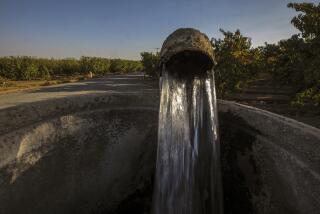Ojai, Water Providers Seek to Form Authority for Basin
- Share via
The city of Ojai, two public water agencies and a private water company are trying to form a new authority to manage the pumping, quality, and replenishment of ground water in the Ojai area.
“I think everyone is convinced that the basin needs to be managed before we have a problem with it,” said John Johnson, general manager of the Casitas Municipal Water District.
Johnson met Friday with representatives of Ojai, Southern California Water Co. and the Ojai Water Conservation District to discuss the idea. State Sen. Gary K. Hart (D-Santa Barbara) plans to introduce legislation in January to allow creation of the authority, Hart assistant Beverly O’Gorman said.
The Ojai basin stretches for about eight miles from the Ojai foothills on the east to the Ventura River on the west. Ojai residents receive about 75% of their water from the basin through four wells operated by Southern California Water.
Many farmers and at least five smaller water companies also rely on well water from the basin. “I don’t think anyone really knows who has straws into the basin and who doesn’t,” Johnson said.
And as the region enters its fifth year of drought, experts are unsure how much water remains.
“It’s our major water supply, and since there is no management or coordinated record-keeping, we thought it necessary to explore whether there can be some structure for managing the water to be used efficiently,” Ojai City Manager Andrew S. Belknap said.
Citrus grower Robert Calder Davis, who irrigates his groves with two wells that tap into the basin, said he commends the effort. “We have to manage our resources or this land will return to a desert,” he said in an interview.
The Ojai basin was the main water supply for most of the Ojai Valley until ranchers and the federal Bureau of Reclamation built the Lake Casitas reservoir in the 1950s to supplement water supplies. The drought has left the lake at only about half its capacity.
“The fact the lake is basically out of water makes the underground resource all the more important,” Belknap said.
Casitas engineers estimate about 4,200 acre-feet of water are pumped from the basin each year. (An acre-foot is enough to cover an acre with a foot of water, and is considered enough to supply a family of five for a year.) Under normal rainfall conditions, the basin absorbs 23,000 acre-feet of water per year.
Recharging the basin is the primary mission of the Ojai Water Conservation District, which until last month was called the San Antonio County Water Conservation District.
The district maintains a series of spreading ponds that divert water from San Antonio Creek so that it percolates into the ground rather than running into the Ventura River and Pacific Ocean.
The settling ponds were virtually wiped out in 1985 by the county’s emergency flood preparations, which involved replacing the ponds with structures to catch floodwater and debris after a major forest fire left the hills barren of vegetation. New holding ponds were completed only last April.
Johnson said the group will meet again on Jan. 9 to continue exploring the responsibilities and costs of forming the authority.
“It’s not clear yet who can be part of that authority,” Johnson said. “We’re not trying to exclude anyone. Should we decide to go ahead, we’re interested in including other parties that have the ability to pump out of the basin.”
Ventura County supervisors and officials of the city of Ventura are being informed of the agencies’ actions, Johnson said. Ventura receives water from Lake Casitas and the Ventura River basin, among other sources.
Belknap said he will report on the group’s progress at the next Ojai council meeting Jan. 8.
More to Read
Sign up for Essential California
The most important California stories and recommendations in your inbox every morning.
You may occasionally receive promotional content from the Los Angeles Times.













